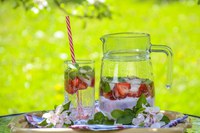Prairie Fare: Stay hydrated past the dog days of summer
(Click an image below to view a high-resolution image that can be downloaded)
Louie entered our home with his tongue almost touching the floor. He was thirsty after being outside on a hot day.
I brought him some water with plenty of ice cubes. He drinks more water when it is ice-cold.
Since Louie is a slightly spoiled dachshund (“weiner dog”), his tongue actually is close to the floor. He has long, wiry fur, so the hot days of summer are a challenge.
He doesn’t have the luxury of removing a layer of clothes. He acts a little embarrassed when he gets a summery “buzz cut” at the groomer.
July 3 to August 11 are the “dog days of summer” according to most references. Good for us, these long, hot “dog days” are already past us, officially.
Does this expression have anything to do with our canine friends? The answer is “kind of.”
A “dog” is involved, but the dog is part of a constellation. Earlier civilizations did not have phones and the internet to keep them entertained, so they looked to the sky. In Greek mythology, Sirius was Orion the hunter’s dog in a group of stars. Therefore, Sirius (“Canis Major” or the “Greater Dog”) is known as the “dog star.”
Sirius is an especially bright star in the sky during the “dog days.” The dog star has been visible to human eyes long before telescopes were invented.
In early times, the intense, oppressive heat of mid-summer occurred during the time the star shone at its brightest. Unfortunately, this time was linked with drought and diseases. Of course, no air conditioning or other modern conveniences were available.
As we continue to enjoy warm summer weather, we need to keep hydration in mind. Keep an eye on any pets you have, too.
Our bodies are made up of about two-thirds water, and we need a continual supply of fluid to keep our bodies well-hydrated in all seasons. Summer heat can be dehydrating, but so can winter cold.
As we grow older, our thirst mechanism does not work as well. Although you may have heard that we should drink 8 cups of water daily, that isn’t a hard and fast rule. All fluids from food and beverages count, not just plain water.
Fluid needs also vary person to person. Some people need 8 or 9 cups of fluid and others, up to 15.
Caffeinated beverages and alcohol-containing beverages are not as effective in hydrating our bodies.
Our needs for fluid depend on our health, our activity level, the temperature and humidity. During hot days, we need to drink plenty of fluids or eat hydrating foods such as fruits and vegetables. Most fruits and vegetables are 90% or more water by weight.
Adequate hydration from water and other fluids helps our bodies maintain a normal temperature and cushions our joints, protects our tissues and helps our bodies eliminate wastes.
Fortunately for us, we have a good “barometer” of hydration every time we use the bathroom. Straw-colored urine is a good indication of hydration status, but remember that some foods and medications can affect urine color.
Pregnant or lactating women need more water. If you are sick with a fever, vomiting or diarrhea, your fluid needs increase.
If you work or play outside in warm climates, you may need extra fluid. For most situations, plain water is all you need to rehydrate. Athletes may need a sports beverage depending on their level of activity. In general, having a meal along with a beverage will replenish any electrolytes (minerals) that may be lost in perspiration.
Here are some additional tips about staying hydrated during the remaining days of summer. These tips were adapted from the Centers for Disease Control and Prevention:
- Carry a water bottle for easy access when you are at work or running errands. Keep it by you at your desk, easy chair and vehicle. Wash your water bottle daily.
- Freeze some water in freezer-safe water bottles. Take one with you for ice-cold water all day long.
- Choose water instead of sweetened beverages. This also can help with weight management. Substituting water for one 20-ounce sugar-sweetened soda will save you about 240 calories.
- Choose water when eating out. Generally, you will save money and reduce calories.
In many restaurants and hotels, infused water is provided for guests. These refreshing unsweetened beverages are nearly calorie-free and low in cost. Here’s how to make your own.
Flavor-infused Water
- Choose a fruit, vegetable or herb (or a creative combination). These can include lemon, lime or orange slices, cucumbers, fresh or frozen strawberries or blueberries, mint leaves, basil leaves, or others.
- If you are using fresh fruits, vegetables or herbs, be sure to rinse them carefully under cool, running water. When using citrus fruits, slice them thinly. Cut strawberries in half and leave other berries whole.
- Fill a pitcher with cold water and ice. Place the pitcher in the refrigerator and allow to stand a few hours. Citrus fruits infuse flavors quickly, while berries need a few hours.
- Serve flavor-infused water instead of soft drinks or sweetened beverages. You can refill the pitcher with water at least one more time. Keep refrigerated and enjoy.
(Julie Garden-Robinson, Ph.D., R.D., L.R.D., is a North Dakota State University Extension food and nutrition specialist and professor in the Department of Health, Nutrition and Exercise Sciences.)
NDSU Agriculture Communication – Aug. 17, 2023
Source: Julie Garden-Robinson, 701-231-7187, julie.garden-robinson@ndsu.edu
Editor: Elizabeth Cronin, 701-231-7881, elizabeth.cronin@ndsu.edu




